At Tata Steel, we are in constant pursuit of minimising our environmental footprint and conserving the natural environment around us. Our philosophy of resource efficiency guides our investment decisions to monitor and mitigate the impact of our operations.
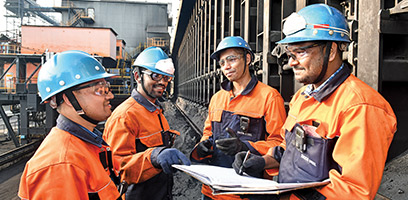
Tata Steel aims to achieve emission intensity <2 tCO2/tcs by 2025. Further, we aim to achieve CO2 emission intensity of <1.8 tCO2/tcs for Tata Steel India by 2030. We continue to implement Internal Carbon Pricing in our capital expenditure appraisal process with the shadow price of carbon at US$15/tCO2.
We are working on deployment of key enablers for deep decarbonisation, including the use of more scrap in steelmaking, use of alternate fuels such as natural gas and hydrogen, and deployment of carbon capture and storage/utilisation technologies.
Highlights of our CO2 emission reduction projects:
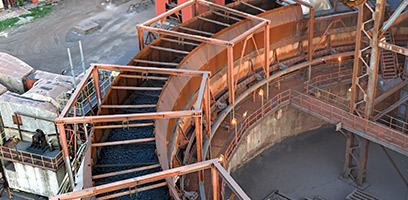
2.29 tCO2e/tcs
GHG EMISSION INTENSITY AT TSJ
0.29 kg/tcs
DUST EMISSION INTENSITY AT TSJ

2.25 m3/tcs
Specific water consumption AT TSJ
Rated ‘A-’ for Climate
Change and Supply Chain
disclosure in CDP 2020
Confederation of Indian
Industry 3R Awards
2020 awarded Tata Steel
for Excellence in Waste
Management

Steel is 100% recyclable and we are setting the bar in the industry with our steel recycling business that will help meet the growing demand for steel in a sustainable manner. It will formalise the scrap market in India and help the country transition to a scrap-based steelmaking route for a more sustainable future.
0.21 m3/tcs
EFFLUENT DISCHARGE
INTENSITY AT TSK
100%
TOTAL SOLID WASTE
UTILISATION AT TSJ

<2 tCO2/tcs GHG emission intensity






While Tata Steel’s current
operations in India are not
located in any of the identified
biodiversity hotspots or
protected areas, our mining
operations (being extractive
in nature) impact the flora and
fauna in the region.
During FY 2020-21, we developed
BMPs for Jamshedpur and Kalinganagar, planted over 2.98
lakh saplings of native species
across locations, developed a
12-hectare Ecological Importance
Park on MSW Dumpsite at
Jamshedpur and rejuvenated
the 5.6 hectare CRM Bara Pond
at Jamshedpur. By FY 2020-21,
we have developed BMPs for 11
locations and plan to cover 100%
of our sites by 2025.





Our inclusive programmes give us the opportunity to work with and help communities flourish with us. We have partnered with various organisations and will continue to deepen our engagement with communities.

Prioritising maternal and child health
FY 2020-21 outcomes
58,000
PEOPLE WERE REACHED OUT TO ON THE HEALTH AND SURVIVAL OF WOMEN AND CHILDREN BEFORE, DURING AND AFTER CHILDBIRTH
Focus on water consumption and effluent discharge
FY 2020-21 outcomes
ASPIRE TO ACHIEVE SPECIFIC WATER CONSUMPTION OF
2 M3/TCS BY 2025 ACROSS ALL STEELMAKING SITES

Improving <2 million lives

Thousand Schools Programme facilitates education for children, through better teaching and learning methods, while improving school governance through School Management Committees. A lockdown learning model was devised for rural children, especially girls facing challenges with access to digital devices and networks, potentially driving increased dropouts and permanent learning disruption.
Learning Beyond School a fully-community-managed education resource centre that enables children to learn beyond school hours and become familiar with digital technology.
FY 2020-21 outcomes
4,600 youth
REACHED THROUGH 54 COMMUNITY-RUN EDUCATION RESOURCE CENTRES IN ODISHA
Residential camp schools, known as Masti Ki Pathshala, cater to children who are either dropouts or from vulnerable backgrounds engaged in child labour.
Saving Lost Childhood programme aims to reduce child labour in Jamshedpur.
FY 2020-21 outcomes
187
CHILDREN MAINSTREAMED UNDER MASTI KI PATHSHALA

Technical education institutes improve employability of the youth in our community through professional skilling courses.
Ek Pahal is a skilling initiative to constructively engage prison inmates by imparting in-house training to enable them to secure gainful employment, both within and outside the jail.
Digital skills for rural children imparted through a classroom-on-wheels, Kaushalyan, using an air-conditioned bus with workstations, an LED TV display as well as a trained computer faculty.
Women Self-help Groups (SHGs) created in our communities to help impart skills and empower them to run an enterprise.
Outcomes
12,000
WOMEN REACHED UNDER EMPOWERMENT PROGRAMMES THROUGH SELF HELP GROUPS
Improve agricultural productivity by investing in enhanced irrigation facilities for the community, waste land development and other allied activities.
Outcomes
`65,000
INCREASE IN THE INCOME OF 24,693 FARMERS THROUGH SEVERAL AGRICULTURAL RELATED LIVELIHOOD INTERVENTIONS

Empower youth by training stakeholders and providing them access to unparalleled sports facilities and nurturing sporting talent with career potential.
Outcomes
3,770
YOUTH ENGAGED THROUGH DIFFERENT SPORTS ACTIVITIES

Samvaad serves as an international platform for discussion among tribal communities.






Investing in people, striving to be the employer of choice, while creating a safe and healthy workplace constitute key priorities for Tata Steel. Industrial harmony of 90-plus years and a century-old trade union is a testament to our culture of ‘working together’.

We have instituted policies that drive a culture of safety consciousness and prevention across our entire operations. Our commitment is reflected in the successful ramp-up of the Kalinganagar facility while maintaining the best practices in health and safety.
Leadership capability building at all levels to achieve zero harm and promote a safety-positive behaviour
Outcomes
~25%
REDUCTION IN LOST TIME INJURIES
Elimination of safety incidents on road and rail to achieve safe, efficient and smart transport
Outcomes
Competency and capability building to mitigate hazards and manage risks
Outcomes
Contractor safety risk management to engage and empower the sizeable contract workforce
Outcomes
Process safety management to ensure effective control of risks at high-hazard operations
Outcomes
1.02%
IMPROVEMENT IN HEALTH INDEX

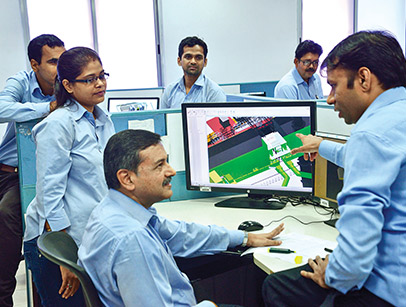
We continued on our productivity improvement journey through various focussed initiatives. Technology and Agility played a crucial role in minimising the impact of COVID-19 on the organisational performance with our productivity remaining at 745 tonne/employee/year.
During FY 2020-21, we undertook several initiatives such as throughput improvement and other operational excellence projects, value engineering, cycle time reduction, along with efforts to identify redundancy through right skilling, Sunhere Bhavishya Ki Yojna (SBKY). We have made great stride in simplifying the organisation’s structure, systems and processes.
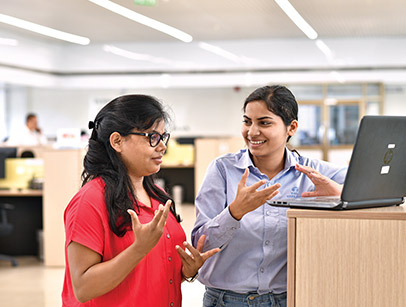
745 tcs/employee/year
EMPLOYEE PRODUCTIVITY
₹1.99 lakh
PERSON-DAYS OF EMPLOYEE TRAINING PROVIDED

MOSAIC (the Diversity and Inclusion Committee)
drives diversity and inclusion indicatives across the
four aspects of Gender, Person with Disabilities
(PwDs), LGBTQ+, and different sections of society
(e.g., Affirmative Action Community) at Tata Steel.
During FY 2020-21, we deployed the first batch of
22 women as heavy machinery operators at the
Noamundi iron mine, ensured active presence
in Tata group’s ‘We@ Tata’ programmes, and
introduced physical and digital infrastructural
changes to make the workplace more inclusive.
Continuous efforts are also being made on hiring as
well as retaining and developing women leaders,
which have led to an increase in gender diversity
and a reduction in attrition of female employees
from 8% to 6%.
We have rolled out unique policies to drive diversity and inclusion:
Best Workplace in Manufacturing Sector in India
Improve employee productivity
25% diversity in workforce by 2025
To be a benchmark in employee engagement and experience
Achieve Zero Harm

25% diversity in workforce

The unprecedented health crisis triggered by the COVID-19 pandemic not only posed significant threat to human life, but also impacted livelihood.
As the containment measures brought economic activities to a halt, socio-economic fallout was significant. At Tata Steel, we rolled out multi-pronged programmes to ensure the health and safety of all stakeholders, while boosting healthcare infrastructure and providing immediate relief to the community.

During the first wave of COVID-19, the Tata Steel Foundation (TSF) undertook a 10-point #CombatCovid19 programme, reaching out to more than 10.5 lakh people across India.
The programme was recalibrated in early 2021 and has reached over 4.5 lakh people since. The basic objectives remain:
Reached out to
10.5 lakh
LIVES DURING THE FIRST WAVE
6,000+
HOURS OF VOLUNTEERING
The primary emphasis in 2021 has been on expeditiously closing gaps in key consumables and equipment available with public health systems that serve communities in remote areas of Jharkhand and Odisha. These include ~50,000 home isolation kits, 3,78,000 testing kits, 10 ventilators and oxygen concentrators, while more than 6,000 oximeters and 2,000 thermal scanners have been provided to frontline health workers to aid effective early detection.
Vaccination remains one of the primary goals as well as challenges. Sensing the need to increase awareness around vaccination, as well as drive large-scale vaccination, we adopted a three-pronged approach to bring communities in and around our operational areas on board. Our digital campaign, #ApnoKiSuno, focussed towards effective behavioural change communication through crowd-sourced videos from Village Heads on critical issues relating to vaccination. These videos helped secure 10,000+ registrations.
We are also helping people register online for COVID-19 vaccination. What began as an initiative in Odisha and Jharkhand has now turned into a nationwide campaign, reaching out to ~40,000 people through our #DigitalBridges programme. Moreover, it also helps reduce crowding in facilities that provide public services. Along with Tata Main Hospital, Jamshedpur and the state government, we are facilitating vaccination at seven centres in the city.
Our employee volunteering initiative, #FarRishta, has been activated to lend a helping hand at major vaccination centres in Jamshedpur. Till date, ~45,000 people have been reached out across seven states through more than 6,000 hours of volunteering.
Other initiatives under the #CombatCovid19 programme

#ThoughtforFood
Worked with the District Administration to provide warm wholesome meals to 50,000 families a day in the worst-affected settlements and slums in Jamshedpur
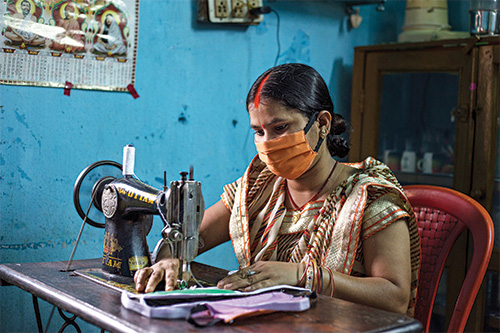
#StitchinTime
Engaged with communities to make 50,000 three-ply cloth masks for frontline health workers in need of Personal Protective Equipment
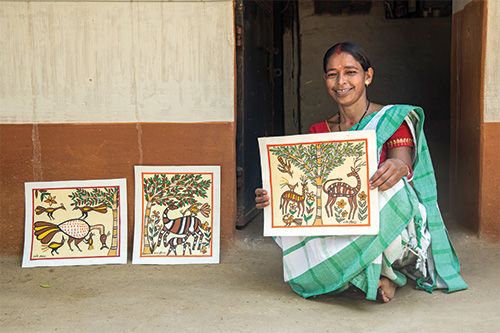
#CashforWork
Helping increase the average income of 1,000 households by promoting kitchen gardens, linking farm produce to markets, making bags from newspapers and creating art and textile designs
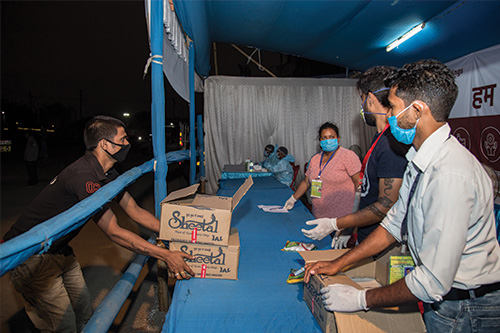
#HopeSprings
Designed modules with trained psychiatrists and happiness practitioners to pre-emptively address any trauma faced by migrant labour brought upon due to the pandemic
#FriendinNeed
Created a Suicide Prevention Centre with a team of dedicated volunteers, extending emotional support during the pandemic

We set up a 24x7 COVID-19 helpline for employees across locations to disseminate accurate and quick information, including those related to HR and medical.
Speak Up, a Coronavirus Guidelines Violation Reporting Helpline, was created and used extensively for reporting any violations of quarantine rules. For employees who lost their lives to COVID-19, we have extended our social security schemes to the family, including medical benefits; this policy covers both frontline employees and shop floor workers.
The pandemic also invalidated the traditional thinking of productivity being contingent on fixed hours of work within an office environment and bust many myths around remote working. We implemented an Agile Working Model in November 2020. Flexible working provided employees the freedom to select work locations of their choice and helped them make decisions pertaining to their personal life to enable better work-life balance.
The new policies have encouraged a trust-based, outcome-driven culture as well as helped attract and retain the best talent available. Having invested in our digital platforms for improved connectivity, we could seamlessly implement the model to ensure continuity of work for employees in their respective environment, presenting more opportunities for them.

We have set up health infrastructure at all our manufacturing and mining locations across Jharkhand and Odisha to ensure the health and well-being of our people and communities.
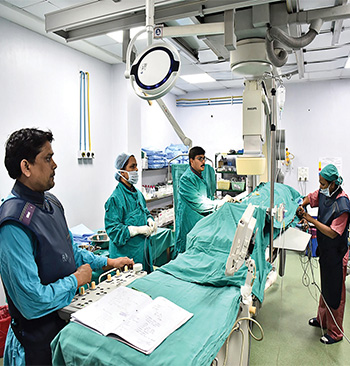
We coordinated with state governments and local administration to establish COVID Care facilities at all our operating locations.
The 1,000-bed Tata Main Hospital (TMH) at Jamshedpur in Jharkhand has 450 oxygen beds and 78 ventilator beds dedicated for COVID care. In addition, 100 oxygen beds have been provided to two subsidiary company hospitals and a 150-bed COVID care. Centre has been set up for asymptomatic patients and those showing mild symptoms.
In Odisha, the Tata Medica Super Specialty Hospital in Kalinganagar has 120 beds with provision of oxygen and ventilators dedicated to COVID Care, including a 15-bed ICU facility. Along with the Odisha Government and district administration, the NC Autonomous College at Jajpur has been converted into a 200-bed COVID Care Centre. At the Tata Steel BSL plant in Dhenkanal, a 200-bed COVID Care facility has been set up with oxygen supply and equipped with oxygen concentrators.
COVID Care facilities have also been set up at different locations. A total of 631 beds have been set up across our operational areas in Jharia, West Bokaro, Noamundi in Jharkhand as well as Joda and Gopalpur in Odisha.
We are establishing 1,500-bed COVID hospitals (facilities with oxygenated-beds) at all our manufacturing locations to augment the existing healthcare infrastructure.

The second wave of the COVID-19 pandemic saw an increase in demand for oxygen for medical use. We are collaborating with all stakeholders to optimise the LMO supply chain.
We have been collaborating with the central and state governments to augment the supply chain of Liquid Medical Oxygen (LMO) in the country. Under guidance from the Steel Ministry, we have been supplying LMO from our steel plants at Jamshedpur in Jharkhand and Kalinganagar and Dhenkanal in Odisha.
Regular route optimisation exercises combining different modes of transportation such as roadways, rail and air transport have resulted in improvement of turnaround time of oxygen tankers and optimisation of the entire LMO supply chain. Further, a series of initiatives involving technological process improvements at oxygen generating plants have led to an over eight-fold increase in LMO supplies from our plants from March to May 2021.
While there have been collaborative efforts from the Central Government, state governments and steel companies to manage the supply chain of LMO in the country, we have taken a proactive approach to set up large-scale COVID Care facilities with oxygenated beds close to our steel plants to enable usage of oxygen near its production source and reduce time taken for transportation of LMO to the extent possible.
55,000 tonne
LIQUID MEDICAL OXYGEN SUPPLIED TILL MAY 2021
